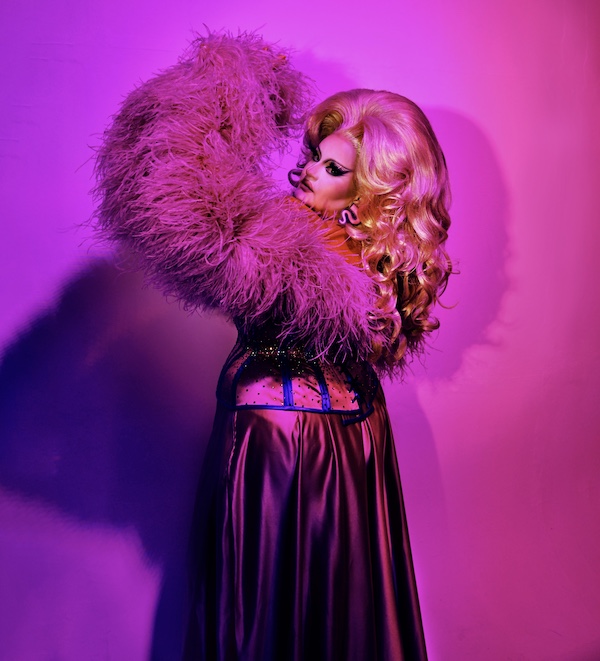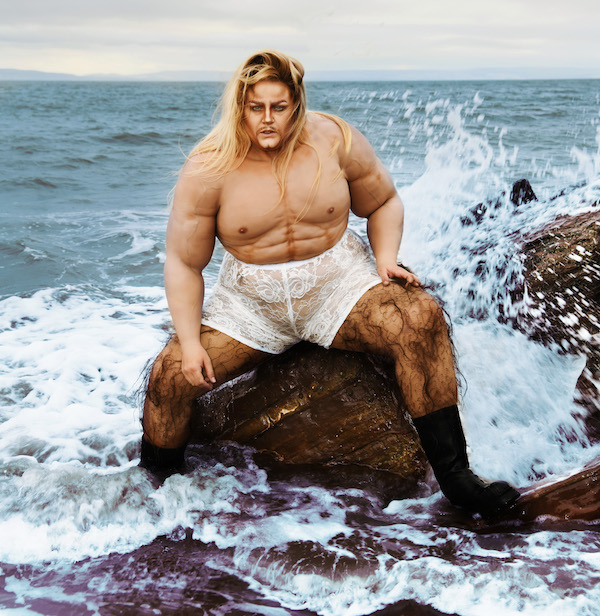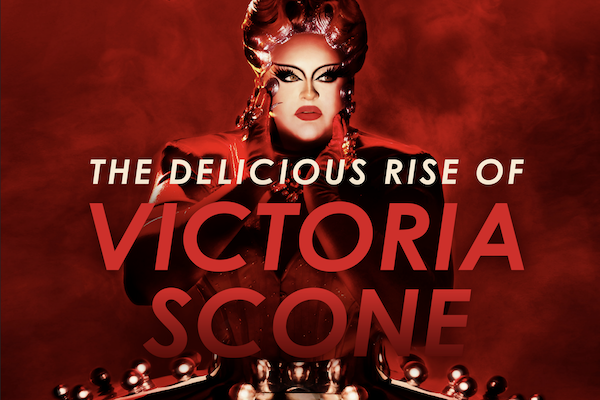It’s not every day that a lesbian from Wales takes over the internet and makes drag race history, but Victoria Scone has always been one to stand out.
In 2021, Scone made history by becoming the first cisgender woman to compete in the RuPaul’s Drag Race franchise. Across two seasons on the show, she achieved a number of firsts and ignited a conversation about how much more diverse mainstream drag can (and should) be.
Scone first set her sights on drag as a child attending pantomimes. A uniquely British tradition, pantomimes are theatrical performances created for children around Christmas time. Typically based on fairy tales, they include jokes and music. Scone was taken by the drag queens in the performances, rather than the pretty princesses other girls tended to focus on. “I guess I’ve been a drag queen since birth,” Scone jokes.
As she grew older, Scone explored her love for the stage by studying musical theater. With her quick wit and the popularity of singing in UK drag performances, drag seemed to be a natural combination of Scone’s talents. “When I told others that I was doing drag, they were confused—especially my mother,” Scone says. But once people saw her perform, they understood Scone’s passion. “Drag isn’t about what’s between your legs—it’s about entertainment,” she says.

Originally, Scone went by “Victoria Sponge,” but with multiple drag queens in the UK sharing the name, Scone decided to change it up. “I thought I’d make it a pun. When people ask, ‘Where’s Victoria?’ someone would answer back ‘Victoria’s gone.’”
While Scone certainly isn’t the first cisgender woman to perform as a drag queen, she’s arguably the most internationally known right now. There aren’t many cisgender women drag acts in Wales, as most tend to congregate in more metropolitan areas, like London. However, Scone explains that cisgender women in drag have created a strong community that’s growing. For those interested in the craft, Scone recommends they take the leap: “Try it if you want. Do whatever the hell you want to do. Don’t listen to naysayers. I certainly wouldn’t be here if I had.”
Scone first entered the world of RuPaul’s Drag Race in 2021 on season three of Drag Race UK. At the time, the reality of being the first cisgender woman queen to compete didn’t get to her at all. “It felt right. I was confident in my looks and what I was presenting,” she says. Unfortunately, Scone was out of the running almost as soon as fans met her: In the first episode of the season she tore her ACL during a lip sync against Krystal Versace. She ultimately left the competition because of the injury. “To leave then was devastating,” Scone says.
Luckily, the departure didn’t spell the end of Scone’s time in the spotlight. In 2022 she returned to the franchise to compete in Canada’s Drag Race: Canada vs. the World. In doing so, she brought diversity to the forefront throughout her time on the show. For her “air, body, lace” look, Scone walked the runway as a drag king—another first for the franchise. During the episode’s confessional, Scone explained that her Fabio-inspired performance was a “love letter” to drag kings. “I am not a drag king, but there are kings in my drag family and I have so much respect for them. Too many people don’t know that drag kings exist, but they’re honing their craft without the same opportunities that drag queens are provided,” she explains.
It’s rare to have a first on the runway after 14 seasons and over a dozen Drag Race offshoots. “I was terrified. Would the audience like it?” Scone says. The high praise she received from the judges for the look silenced critics who argue that including drag kings in the franchise would require a different scoring system. Scone’s drag king look was a response to the same brief the other contestants answered and she absolutely knocked it out of the park. She would love to see drag kings on the runway in the future: “Imagine a whole season of Fabios!”

Scone also ignited a conversation around vocabulary in her time on Canada’s Drag Race: Canada vs.the World. The word “fishy,” is often used by queens to refer to a very feminine queen. However the term is based on the harmful misconception that women have foul-smelling genitals.
Scone didn’t plan to bring up the term, but once the opportunity presented itself, she felt she had to. “If I had been in the changing room at a club before a performance, I would have said something, absolutely. But this is different. I was terrified but I thought, ‘Who am I to have this privilege and platform and not speak up?’” Since the scene aired, many queens have approached her, thanking her for educating them on the origins of the term. However, Scone is quick to explain that she’s not asking anyone to change their language on account of her—she’s simply trying to start a conversation.
Scone made it to the top four this round, and while she didn’t walk with the crown, she did leave with a much bigger win. During the final episode of the season, Scone completed the first proposal in Drag Race history, taking a moment to ask her girlfriend Dani to become her wife. At a watch party for the final episode, Scone was able to ask Dani face-to-face and secure an enthusiastic, “yes!” “It was a beautiful reminder that queer love and queer stories is actually what Drag Race is all about,” Scone says.
Since leaving the latest round of Drag Race, Scone has been touring the UK with Death Drop: Back in the Habit, and will stay with the show until March. The show is wonderfully queer, featuring a host of well known drag queens and kings. “I love being on tour and being creative with queer people. It’s this serious thing, but it’s not too serious—you can just imagine the trouble we get up to!” Scone says. The tour wraps in March and after that, Scone is hoping for another call from the folks at Drag Race. “My plan is to keep going back until I win!” she says.


